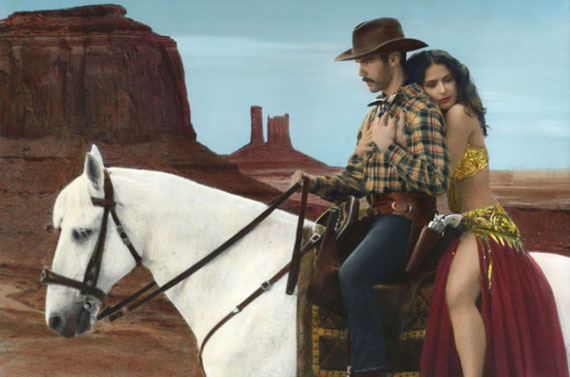
2015
Hand colored gelatin silver print
© Youssef Nabil
Youssef Nabil »
I Saved My Belly Dancer
Exhibition: 6 Nov 2015 – 6 Jan 2016
Galerie Nathalie Obadia
91, rue du Faubourg Saint-Honoré / 3 rue du Cloître Saint-Merri
75004 Paris
+33(0)1-42746768
info@galerie-obadia.com
www.galerie-obadia.com
Tue-Sat 11-19
The Galerie Nathalie Obadia is delighted to present in its Parisian space Youssef Nabil’s second personal exhibition I Saved My Belly Dancer. After, the success of You Never Left, their previous collaboration in 2010 and his very well received monographic exhibition at the Maison Européenne de la Photographie in 2011, this show will be displaying a new video by the artist.
I saved My Belly Dancer is a poetic depiction of Youssef’s fascination with belly dancers, and his anxiety over the disappearance of the art form that is unique to the Middle East. The 12-minute video is visually inspired by the 50s golden age cinema of Egypt and touches upon Youssef’s fraught relationship with his home country – both elements that inform a large aspect of his practice.
A sleeping man (Tahar Rahim) dreams that his old glamorous, Egypt is disappearing and a last remaining belly dancer (Salma Hayek) comes to comfort him and tell him that his world has not vanished.
She dances for him a last dance before he takes her with him to the American desert where he now lives. The video progresses without any dialogue, and the imagery is ubiquitous with surrealism and symbolism that makes Youssef’s work much more than unassuming reminiscence.
Memory, exile and rebirth continue to be a recurring theme in Youssef’s work. The video is a self-portrait of his history and relationship with Egypt – and his separation from it – as well as what is left of the past within memory; even if it is no longer a part of our reality.
The video also explores shifting perceptions of the position of women in the region, with the amplified sexualisation of their bodies a growing problem in the new social constructs. It is this, and the fear of losing an indigenous art form to time and changing ideologies, that inspired Youssef to work on I Saved My Belly Dancer, the second video in his career.
The photographic work produced from this video is done in Youssef’s characteristic technique of hand colouring black and white photographs – one that finds inspiration in the movie posters and billboards of the Egyptian cinema of the mid twentieth century.
----------------------------
Youssef Nabil was born in Egypt in 1972, and lives and works in New York.
Three monographs have been published on Nabil’s work – Sleep In My Arms (Autograph ABP and Michael Stevenson, 2007), I won’t let you die (Hatje Cantz, 2008) and most recently, a self-titled monograph Youssef Nabil published by Flammarion (2013). In 2010, the artist known for his work combining photography and painting presented his first video You Never Left, an 8-minute piece with the actors Fanny Ardant and Tahar Rahim. I Saved My Belly Dancer is the second video in his career.
Youssef’s work has been presented in numerous solo and group exhibitions at venues including The Villa Medici, Rome; La Maison Rouge, Paris; The British Museum, London; Galleria dell’Accademia, Florence; MMK Museum für Modern Kunst, Frankfurt; Centro de la Imagen, Mexico City; North Carolina Museum of Art, North Carolina; BALTIC Centre for Contemporary Art, Newcastle; Michael Stevenson Gallery, Cape Town; Galeria Leme, São Paulo; Gemäldegalerie, Staatliche Museen zu Berlin; Centre de Cultura Contemporánea de Barcelona, MACBA, Barcelona; Victoria & Albert Museum, London; Institut du Monde Arabe, Paris; Kunstmuseum, Bonn; Smithsonian National Museum of African Art, Washington, D.C; The Third Line, Dubai; The Kennedy Center, Washington DC; Centro Andaluz de Arte Contemporáneo, Sevilla; and Aperture Foundation, New York.
Youssef’s work is part of various international collections including LACMA Museum, Los Angeles; The Louis Vuitton Foundation, Paris; Sindika Dokolo Foundation, Luanda; La Maison Européenne de la Photographie, Paris; The joint collection of The British Museum and The Victoria & Albert Museum, London; Centro de la Imagen, Mexico City; Mathaf Arab Museum of Modern Art, Doha; and most recently the Guggenheim Museum, Abu Dhabi and The Studio Museum in Harlem, New York.�